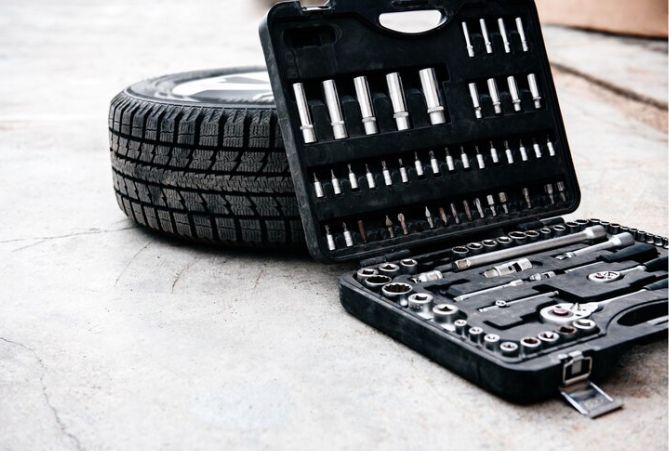Changing a tyre may seem intimidating if you’ve never done it before, but with the right preparation and steps, you can get back on the road quickly and safely. Here’s a comprehensive guide to help you change a tyre efficiently.
Assess Your Safety First
Before you begin, ensure your safety and that of your passengers:
- Is your car in a safe location? Make sure it’s away from traffic.
- Are you visible to other drivers? Use hazard warning lights and reflective gear if available.
- Can you change the tyre safely at this spot? If not, move to a safer location.
Once you’ve ensured safety, apply the handbrake, switch on hazard lights, and place a warning triangle behind your vehicle. Have passengers exit the car and move to a secure area.
Tools You’ll Need:

Before starting, gather the following items:
- Car jack
- Wrench
- Wheel chocks (or suitable substitutes like bricks)
- Wheel nut key (for locking nuts)
- Car handbook
- Torch (for low-light situations)
Ensure your spare tyre is in good condition before proceeding.
Step-by-Step Tyre Change Process:
Step 1: Stabilise Your Vehicle with Wheel Chocks
Place wheel chocks diagonally opposite the flat tyre. For example, if your front-left tyre is flat, put a chock behind the rear-right tyre. If you don’t have dedicated chocks, use bricks or a sturdy plank of wood.
Step 2: Position the Car Jack
Refer to your car’s handbook to find the best jacking point near the flat tyre. Proper placement prevents damage to the vehicle’s undercarriage. Extend the jack until the car rises slightly without lifting the wheels off the ground.
Step 3: Loosen the Wheel Nuts
While the tyre is still grounded, use the wrench to turn the wheel nuts counterclockwise. Loosen them but do not remove them completely at this stage.
Step 4: Lift the Vehicle
Use the car jack to lift the vehicle until the flat tyre is completely off the ground. Ensure the car is stable before moving on.
Step 5: Remove the Flat Tyre
Fully unscrew the loosened nuts and remove the tyre. Place the nuts in a secure spot to avoid losing them.
Step 6: Attach the Spare Tyre
Align the spare tyre with the wheel bolts and push it onto them. Replace the wheel nuts and tighten them by hand.
Step 7: Lower the Vehicle and Tighten the Nuts
Carefully lower the car until the spare tyre touches the ground, but do not remove the jack completely. Tighten the nuts in a criss-cross pattern to ensure even pressure.
Step 8: Fully Lower the Vehicle and Store Tools
Lower the car fully and remove the jack. Tighten the wheel nuts once more for added security. Store all tools and the damaged tyre safely in your vehicle.
Final Checks:

- Ensure the spare tyre is secure and correctly inflated.
- Drive cautiously and have the tyre replaced or repaired as soon as possible.
By following these steps, changing a tyre can be a manageable task that keeps you safe and mobile. Practice these steps when you have spare time, so you’re prepared in case of an emergency.
If you find yourself on a motorway or any location where you cannot safely change a tyre, or if you need assistance replacing a damaged tyre with a new one, don’t hesitate to contact us. We’re here to help ensure your safety and get you back on the road quickly.